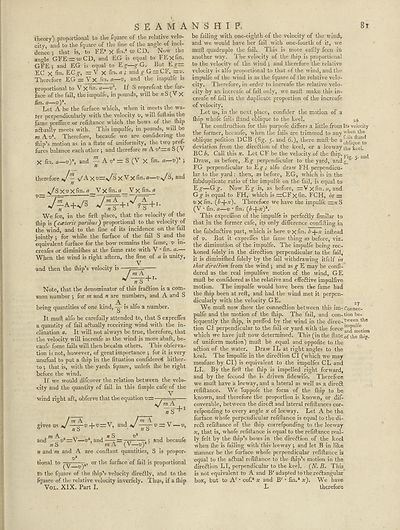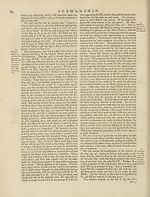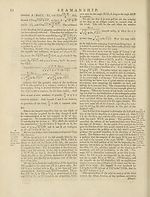Encyclopaedia Britannica, or, a Dictionary of arts, sciences, and miscellaneous literature : enlarged and improved. Illustrated with nearly six hundred engravings > Volume 19, Scripture-SUG
(89) Page 81
Download files
Complete book:
Individual page:
Thumbnail gallery: Grid view | List view

8t
S E A M A
theory) proportional to the r<iuare of the relative velo¬
city, and to the fquare of the fine of the angle of inci¬
dence •, that is, to FE1 X fin.* w CD. Now the
angle GEE — w CD, and EG is equal to FE X fin-
GFE *, and EG is equal to Ej-—g G. But £ ?•=:
EC X fin- EC^, =r V X fin. a ; and^G~CF, ~v.
Therefore EG = Vxfin. a—v, and the impulfe is
proportional to V X fin. a—v1. If S reprefent the iur-
faee of the fail, the impulfe, in pounds, will be /z S (V X
fin. a—v)2.
Let A be the furface which, when it meets the wa-
t?r perpendicularly with the velocity v, will fuftain the
fame preffure or refidance which the bows ol Urn fliip
atlually meets with. This impulfe, in pounds, will be
m A.v2. Therefore, becaufe we are confidering the
Ihip’s motion as in a Hate of uniformity, the two pref-
fures balance each other ; and therefore m A v2z=n S (V
X fin. a—'y)*, and —- A “y* ~ S (V X fin* a—l')1 ?
therefore
y/A X v=>f S X V X fin. a—v*JS, and
^/S X u X fin. a__V X fin. a_ V X fin, a
We fee, in the firft place, that the velocity of the
fiiip is (carteris paribus) proportional to the velocity of
the wind, and to the fine of its incidence on the fail
jointly ; for while the furface of the fail S and the
equivalent furface for the bow remains the fame, v in-
creafes or diminifhes at the fame rate with V • fin. a.—
When the wind is right aftern, the fine of a is unity,
. . v
and then the {hip’s velocity is
J
m A
n S
fi-
Note, that the denominator of this fraftion is a com¬
mon number j for tn and n are numbers, and A and S
being quantities of one kind, -g- is alfo a number.
It muft alfo be carefully attended to, that S expreffes
a quantity of fail actually receiving wind with the in¬
clination a. It will not always be true, therefore, that
the velocity will increafe as the wind is more abaft, be¬
caufe feme fails will then becalm others. This obferva-
tion is not, however, of great importance •, for it is very
unufual to put a (hip in the fituation confidered hither¬
to •, that is, with the yards fquare, unlefs Ihe be right
before the wind.
If we would difeover the relation between the velo¬
city and the quantity of fail in this fimple cafe of the
, • V
wind right aft, obferve that the equation v— ■
' " +1
/nj m A
gives us
J
n S
m A
—,+ll=v,
and
J
, m A
and v
n o
—V —v.
n o
and becaufe
is propor*.
—V—cy* and 4 5
’ mA (V—u)* ’
n and m and A are conflant quantities, S
^ . • .
tional to or the furface of fail is proportional
to the fquare of the fid p’s velocity direefily, ahd to the
iqUare of the relative velocity inverfely. Thus, if a ftiip
VOL. XIX. Part I.
N S H I P.
be failing with one-eighth of the velocity of the wind,
and we would have her fail with one-fourth of it, we
muft quadruple the fail. This is more eafily feen in
another way. The velocity of the fidp is proportional
to the velocity of the wind ; and therefore the relative
velocity is alfo proportional to that of the wind, and the.
impulfe of the wind is as the fquare of the relative velo¬
city. Therefore, in order to increafe the relative velo¬
city by an increafe of fail only, we mull make this in¬
creafe of fail in the duplicate proportion of the increafe
of velocity.
Let us, in the next place, confider the motion of a
{hip whofe fails {land oblique to the keel. 26
The conitruction for this purpofe differs a little from Its velocity
the former, becaufe, when the fails are trimmed to any vviien ,-he
oblique pofition DCB (fig. 5. and 6.), there muft be a^'Jj
deviation from the direction of the keel, or a leeway the keel
BC b. Call this x. Let CF be the velocity of the {hip. an[j
Draw, as before, E^- perpendicular to the yard, andg^’^ an
FG perpendicular to alfo draw FH perpendicu¬
lar to the yard : then, as before, EG, which is in the
fubduplicate ratio of the impulfe on the fail, is equal to
E^—Gjr. Now E^- is, as before, =:V X fin. a, and
G^- is equal to FH, which is —CF Xfin. FCH, or =:
v X fin. (b-\-x'). Therefore we have the impulfe —n S
(V • fin. a—v • fin. (£-}-#)*.
This exprefiion of the impulfe is perfectly fimilar to
that in the former cafe, its only difference confifting in
the fubduftive part, which is here ■yxfin. b-\-x inftead
of v. But it expreffes the fame thing as before, viz.
the diminution of the impulfe. The impulfe being rec¬
koned folely in the direflion perpendicular to the fail,
it is diminiftied folely by the fail withdrawing itfelf in
that direEiion from the wind ; and as ^ E may be confi-
dered as the real impulfive motion of the wind, GE
muft be confidered as the relative and effeftive impulfive
motion. The impulfe would have been the fame had
the ftiip been at reft, and had the wind met it perpen¬
dicularly with the velocity GE.
We muft now ftiow the connexion between this im- Connec-
pulfe and the motion of the ftiip. The fail, and con- tion be-
fequently the ftiip, is preffed by the wind in the direc-!;ween t*1®
tion Cl perpendicular to the fail or yard with the force ”^1 ^motion
which we have juft now determined. This (in the ftate 0f the fliip.
of uniform motion) muft be equal and oppofite to the
aftion of the water. Draw IL at right angles to the
keel. The impulfe in the direflion Cl (which we may
meafure by Cl) is equivalent to the impulfes CL and
LI. By the firft the ftiip is impelled right forward,
and by the fecond file is driven fidewife. Therefore
we muft have a leeway, and a lateral as well as a direfl
refiftance. We fuppofe the form of the ftiip to be
known, and therefore the proportion is known, or dif-
coverable, between the diredl and lateral refiftances cor-
refponding to every angle x of leeway. Let A be the
furface whofe perpendicular refiftance is equal to the di-
ref! refiftance of the ftiip correfponding to the leeway
.v, that is, whofe refiftance is equal to the refiftance real¬
ly felt by the (hip’s bows in the direction of the keel
when (he is failing with this leeway j and let B in like
manner be the furface whofe perpendicular refiftance is
equal to the. aflual refiftance to the (hip’s motion in the
direction LI, perpendicular to the keel. (A. E. This
is not equivalent to A and B' adapted to thexeflangular
box, but to A! * cof.* x and B' • fin.* x). We have
L therefore
S E A M A
theory) proportional to the r<iuare of the relative velo¬
city, and to the fquare of the fine of the angle of inci¬
dence •, that is, to FE1 X fin.* w CD. Now the
angle GEE — w CD, and EG is equal to FE X fin-
GFE *, and EG is equal to Ej-—g G. But £ ?•=:
EC X fin- EC^, =r V X fin. a ; and^G~CF, ~v.
Therefore EG = Vxfin. a—v, and the impulfe is
proportional to V X fin. a—v1. If S reprefent the iur-
faee of the fail, the impulfe, in pounds, will be /z S (V X
fin. a—v)2.
Let A be the furface which, when it meets the wa-
t?r perpendicularly with the velocity v, will fuftain the
fame preffure or refidance which the bows ol Urn fliip
atlually meets with. This impulfe, in pounds, will be
m A.v2. Therefore, becaufe we are confidering the
Ihip’s motion as in a Hate of uniformity, the two pref-
fures balance each other ; and therefore m A v2z=n S (V
X fin. a—'y)*, and —- A “y* ~ S (V X fin* a—l')1 ?
therefore
y/A X v=>f S X V X fin. a—v*JS, and
^/S X u X fin. a__V X fin. a_ V X fin, a
We fee, in the firft place, that the velocity of the
fiiip is (carteris paribus) proportional to the velocity of
the wind, and to the fine of its incidence on the fail
jointly ; for while the furface of the fail S and the
equivalent furface for the bow remains the fame, v in-
creafes or diminifhes at the fame rate with V • fin. a.—
When the wind is right aftern, the fine of a is unity,
. . v
and then the {hip’s velocity is
J
m A
n S
fi-
Note, that the denominator of this fraftion is a com¬
mon number j for tn and n are numbers, and A and S
being quantities of one kind, -g- is alfo a number.
It muft alfo be carefully attended to, that S expreffes
a quantity of fail actually receiving wind with the in¬
clination a. It will not always be true, therefore, that
the velocity will increafe as the wind is more abaft, be¬
caufe feme fails will then becalm others. This obferva-
tion is not, however, of great importance •, for it is very
unufual to put a (hip in the fituation confidered hither¬
to •, that is, with the yards fquare, unlefs Ihe be right
before the wind.
If we would difeover the relation between the velo¬
city and the quantity of fail in this fimple cafe of the
, • V
wind right aft, obferve that the equation v— ■
' " +1
/nj m A
gives us
J
n S
m A
—,+ll=v,
and
J
, m A
and v
n o
—V —v.
n o
and becaufe
is propor*.
—V—cy* and 4 5
’ mA (V—u)* ’
n and m and A are conflant quantities, S
^ . • .
tional to or the furface of fail is proportional
to the fquare of the fid p’s velocity direefily, ahd to the
iqUare of the relative velocity inverfely. Thus, if a ftiip
VOL. XIX. Part I.
N S H I P.
be failing with one-eighth of the velocity of the wind,
and we would have her fail with one-fourth of it, we
muft quadruple the fail. This is more eafily feen in
another way. The velocity of the fidp is proportional
to the velocity of the wind ; and therefore the relative
velocity is alfo proportional to that of the wind, and the.
impulfe of the wind is as the fquare of the relative velo¬
city. Therefore, in order to increafe the relative velo¬
city by an increafe of fail only, we mull make this in¬
creafe of fail in the duplicate proportion of the increafe
of velocity.
Let us, in the next place, confider the motion of a
{hip whofe fails {land oblique to the keel. 26
The conitruction for this purpofe differs a little from Its velocity
the former, becaufe, when the fails are trimmed to any vviien ,-he
oblique pofition DCB (fig. 5. and 6.), there muft be a^'Jj
deviation from the direction of the keel, or a leeway the keel
BC b. Call this x. Let CF be the velocity of the {hip. an[j
Draw, as before, E^- perpendicular to the yard, andg^’^ an
FG perpendicular to alfo draw FH perpendicu¬
lar to the yard : then, as before, EG, which is in the
fubduplicate ratio of the impulfe on the fail, is equal to
E^—Gjr. Now E^- is, as before, =:V X fin. a, and
G^- is equal to FH, which is —CF Xfin. FCH, or =:
v X fin. (b-\-x'). Therefore we have the impulfe —n S
(V • fin. a—v • fin. (£-}-#)*.
This exprefiion of the impulfe is perfectly fimilar to
that in the former cafe, its only difference confifting in
the fubduftive part, which is here ■yxfin. b-\-x inftead
of v. But it expreffes the fame thing as before, viz.
the diminution of the impulfe. The impulfe being rec¬
koned folely in the direflion perpendicular to the fail,
it is diminiftied folely by the fail withdrawing itfelf in
that direEiion from the wind ; and as ^ E may be confi-
dered as the real impulfive motion of the wind, GE
muft be confidered as the relative and effeftive impulfive
motion. The impulfe would have been the fame had
the ftiip been at reft, and had the wind met it perpen¬
dicularly with the velocity GE.
We muft now ftiow the connexion between this im- Connec-
pulfe and the motion of the ftiip. The fail, and con- tion be-
fequently the ftiip, is preffed by the wind in the direc-!;ween t*1®
tion Cl perpendicular to the fail or yard with the force ”^1 ^motion
which we have juft now determined. This (in the ftate 0f the fliip.
of uniform motion) muft be equal and oppofite to the
aftion of the water. Draw IL at right angles to the
keel. The impulfe in the direflion Cl (which we may
meafure by Cl) is equivalent to the impulfes CL and
LI. By the firft the ftiip is impelled right forward,
and by the fecond file is driven fidewife. Therefore
we muft have a leeway, and a lateral as well as a direfl
refiftance. We fuppofe the form of the ftiip to be
known, and therefore the proportion is known, or dif-
coverable, between the diredl and lateral refiftances cor-
refponding to every angle x of leeway. Let A be the
furface whofe perpendicular refiftance is equal to the di-
ref! refiftance of the ftiip correfponding to the leeway
.v, that is, whofe refiftance is equal to the refiftance real¬
ly felt by the (hip’s bows in the direction of the keel
when (he is failing with this leeway j and let B in like
manner be the furface whofe perpendicular refiftance is
equal to the. aflual refiftance to the (hip’s motion in the
direction LI, perpendicular to the keel. (A. E. This
is not equivalent to A and B' adapted to thexeflangular
box, but to A! * cof.* x and B' • fin.* x). We have
L therefore
Set display mode to:
![]() Universal Viewer |
Universal Viewer | ![]() Mirador |
Large image | Transcription
Mirador |
Large image | Transcription
Images and transcriptions on this page, including medium image downloads, may be used under the Creative Commons Attribution 4.0 International Licence unless otherwise stated. ![]()
| Permanent URL | https://digital.nls.uk/192696439 |
|---|
| Attribution and copyright: |
|
|---|
| Description | Ten editions of 'Encyclopaedia Britannica', issued from 1768-1903, in 231 volumes. Originally issued in 100 weekly parts (3 volumes) between 1768 and 1771 by publishers: Colin Macfarquhar and Andrew Bell (Edinburgh); editor: William Smellie: engraver: Andrew Bell. Expanded editions in the 19th century featured more volumes and contributions from leading experts in their fields. Managed and published in Edinburgh up to the 9th edition (25 volumes, from 1875-1889); the 10th edition (1902-1903) re-issued the 9th edition, with 11 supplementary volumes. |
|---|---|
| Additional NLS resources: |
|

